![]()
![]()
![]()
Use LEFT and RIGHT arrow keys to navigate between flashcards;
Use UP and DOWN arrow keys to flip the card;
H to show hint;
A reads text to speech;
29 Cards in this Set
- Front
- Back
|
Parrots
|
Order Psittaciformes
*shor deep downward pointing bill *two toes pointing foward and two pointing backward *short neck *prominent eyes *large head and compact bulky body |
|
|
Colours of Parrots
|
Male and female are similarly coloured in some spp
Some spp females are plainer Eclectus parrot- female more brightly colored |
|
|
What they eat
|
Eat seeds or nectar. Some fruit, leaves, insects.
Beak- tough can break open nuts, can climb around in branches Lorikeets- brushes on tongues |
|
|
Flock
|
Seeds and nectar
-very abundant, not worth defending Safer in groups -dilution effect, many eyes effect |
|
|
Monogamous
|
Pair for life
Some spp, share incubation some females incubate (fed by male) Most all spp- both parents feed nestlings and fledglings Eclectus parrot- only cooperative breeding parrot |
|
|
Groups
|
Cockatoos
Lorikeets Others |
|
|
Cockatoos
|
Large parrots with moveable crests
Most eat seeds Robust bills 12spp in OZ- spp appear to originated here Require large nesting hollows b/c they are large Popular as caged birds |
|
|
Lorikeets
|
Mostly inhabit forests and wetlands
Mostly eat nectar, pollen and flowers Longer thinner bill than other parrots Flowers are ephemeral- tend to wander widely to search for food Garish colors are good camouflage Only in Ausralasuian region 6spp |
|
|
Rainbow lorikeet
|
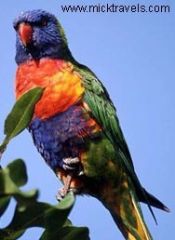
Trichoglossus haematodus
Eastern and northern OZ Do well in cities- in Brisbane Gregarious and aggressive Nest in tree hollow Pair for life |
|
|
OTHER parrots
|
related to parrots with a worldwide disbn, though mostly southern hemisphere
~30spp in OZ rosellas, budgerigars, grass parrots |
|
|
Conservation issues
|
Introduced predators
Habitat destruction Poaching for the pet trade Shortage of tree hollows for nesting Changes fire regimes *worse for spp w/ slow breeding rates |
|
|
Night parrot
|
Geopsittacus occidentalis
Nocturnal Ground dwelling Once widespread in interior Feed on spinifex seeds and to hide in daytime Last specimen was collected in 1912- was thought to be extinct. REDISCOVERY! not seen from 1912-1990 Another found last november in Diamantia Lakes region in W QLD Prob effected by cats and foxes and damage to vegetation by sheep, cattle and rabbits. |
|
|
Ground Parrot
|
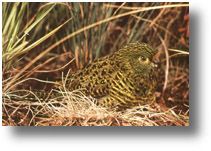
Disjunct disbn'
Status with tasmanian ppln best shape Most time on ground Preferred habitat in open heath Can only be in heath after a fire (~5-15 eyars post fire) frequency is necesary Eat- seeds of grasses, sedges and herbs BREEDING Nest in ground in grass nest (night parrot too) Very secretive birds, little known Rarely seen- surveyed by listening for calls at sunset |
|
|
Orange-bellied parrot
|
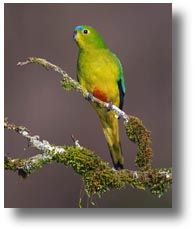
Critically endangered
single breeding ppln left with ~180 adults Breeds in SW tasmania in summer Migratory- leave tasmania in Feb/Mar to Victorian coast Counted every winter Declined since 1940s |
|
|
Causes of decline in orange bellied parrots
|
Habitat modification and increased competition in winter habitat
Period of heavy poaching overlapped with early period of habitat loss Predation by foxes and cats Disease Migration is tough, young must do it for the first time w/o parents |
|
|
Recovery plan for orange-bellied parrots
|
Jointly developed by Victoria, Tasmania, South
Australia, the federal government, Birds Australia and the World Wide Fund for Nature 3rd recovery plan: 1998-2002 • Increase area of winter habitat by 10% • Maintain quality of breeding habitat by fire • Increase survival of adults over winter by 10% • Increase number of birds counted during winter census by 100% • Release 20-30 captive bred birds into wild every year |
|
|
Orange-bellied parrots- recent issues
|
• Issues with development of a big wind farm in Victoria
• Record federal government funding for the species • Last year there was news of a disease wiping out captive populations in Tasmania |
|
|
Paradise parrot
|
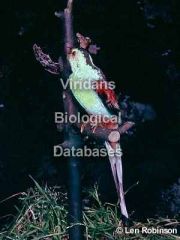
Extinct?
Last reliable report in 1920s Ate- grass seeds in savanah woodlands Mostly on ground Nested- termite mounds (vulnerable to foxes) Problems- overgrazing, drought and fire Trapped |
|
|
Golden-shouldered parrot
|
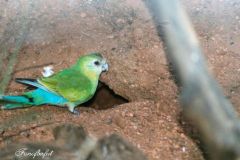
Psephotus chrysopterygius
few cattle stations in central Cape York Peninsula Eat- seeds of grasses and herbs Nest- termite mounds Changes to fire regimes have changed vegetation patterns-> reduced density of termite mounds |
|
|
Conservation of the golden-shouldered parrot
|
About 2000 breeding individuals left in two populations
• Threats: reduced frequency of hot fires, overgrazing, poaching, predation, increase in woody shrubs due to changed fire regimes • Poachers could easily get fledglings from their nests in termite mounds • Goal is to develop pastoral management strategies that work for both this parrot and cattle |
|
|
Dependence of most parrots on tree hollows
|
• Nesting
• Saftey • Rare and must be defended • Hollows usually only develop in old (often dead) trees • Such trees removed by logging or removed in cities for safety reasons |
|
|
Study of ecology and conservation of hole-nesting parrots in the Iron Ranges of Queensland’s Cape York
|
• Robert Heinsohn at Australian National University
• these parrot species in trouble * due to shortage of suitable trees for nesting • low rates of successful reproduction, which makes them very vulnerable to habitat changes |
|
|
Palm Cockatoo
|
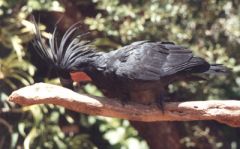
Locally common, tiny range in OZ
Need savannah with rainforest nearby use tree hollows in eucalypt woodland near rainforest Also in NG Illegaly hunted for pet changes in fire regime bad |
|
|
Slow life history of palm cockatoo
|
• Strong competition for nest hollow
• Incubation and chick-rearing take 90-100 days • Always lay only a single egg • Only 9 of 41 breeding attempts studied were successful • 2/3 of nesting failure occurred at nestling stage, 1/3 during incubation • Most failure due to predation • Breed about once every two years • Among the lowest breeding success rate known for any parrot |
|
|
Conservation implications of the palm cockatoo’s slow life history (low reproductive rate)
|
• Would recover only very slowly from any environmental
disturbances • Changes to fire regimes would affect availability of nesting trees in the right habitat • Need further study of effects of fire in this habitat to better understand the threats to the palm cockatoo |
|
|
Eclectus Parrot
|
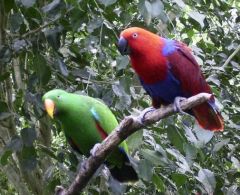
Eclectus roratus
Found in: Cape York Penn, Papua NG, Solomon islands Nest in tree hollows in tall trees emerging form the tainforest Frugivorous Large (500-600g) |
|
|
UNIQUE (eclectus parrot)
|
Reverse dichromatism- females are brighter
Both sexes under strong sexual selection Females spend up to 9mo guarding their nest hole, fed by males Can make unusual sex ratios of young (20 females in a row) Multiple males feed a female (up to 5) All males feeding her are unrelated to her. LOW REPRO SUCESS 18% of eggs and 27% of clutches--> fledging Egg damage/loss, flooding of nest hollow, death of chicks Good hollows- LIMITING resource... why females guard them |
|
|
Survey
|
500 nest trees
538-596 breeding females, 1059-1173 males in ppln only ~150-170 females sucesful at rearing |
|
|
Conservation of nest hollows critical in Iron Ranges
|
• Sulfur-crested cockatoos compete with both palm cockatoos and eclectus parrots for nest hollows
• 3.8% of rainforest nest hollows lost each year • 5.4% of eucalypt woodland nest hollows lost each year • Losses due to fire, trees falling over, floor of nest hollow caving in • Management of these parrots requires maintenance of nest hollows |

